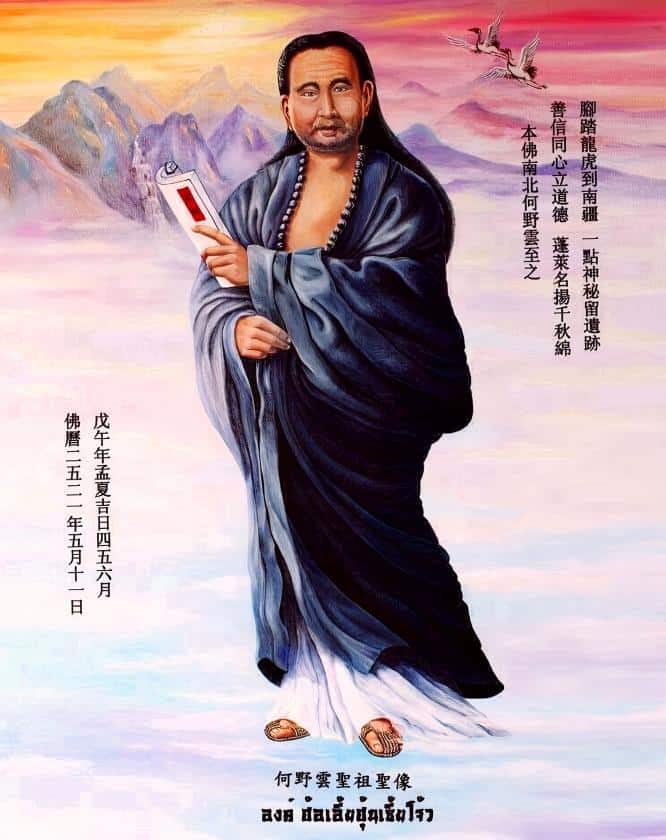有人沉船,有人出米
Teochew Proverb’有人沉船,有人出米’,The literal meaning is that someone sank the ship and someone got the rice because of it.
‘船’ means ship in Chinese,and ‘米’ means rice in Chinese,’人’means people,’有人’means someone.
It means that some people suffer misfortune, while others become rich because of it.
Practice speaking this sentence in Teochew dialect:
Stories start from He Yeyun,a Feng Shui Master
‘有人沉船,有人出米’,there is also one another saying’双溪嘴沉船,石井岩出米’.
‘双溪嘴’&’石井岩’are both names of places where the story happened.
‘双’means double in Chinese,’溪’means streams,’嘴’means mouth which always used to name a river junction.
Legend has it that after He Yeyun died, he was appointed as the water god of Rongjiang River. He was determined to punish evil forces and help the poor.
He Yeyun first observed the terrain of Rongjiang River, settled the aquatic creatures, and appointed lions and elephants to guard the mouth of Rongjiang River. He also ordered the elephant to guard ‘双溪嘴'(Shuangxizui,means where two streams meet) and put Rongjiang River in order.
Punish robbers and help the poor
Soon, people discovered a strange phenomenon: the robbers’ ships often sank in ‘双溪嘴'(Shuangxizui), but rice flowed out of the cracks in 石井岩(Shijingyan,’石’means stone) every day. Therefore, there was a saying that ‘双溪嘴沉船,石井岩出米’,means “Shuangxizui ships sank, and Shijingyan earned rice”.
It turned out that He Yeyun would investigate all passing ships and confiscate all those carrying ill-gotten gains.
Especially the rice obtained by plundering and extorting farmers. Once these sailboats carried rice to ‘双溪嘴'(Shuangxizui), He Yeyun ordered the elusive turtle guarding the ship to capsize it.
The rice was stored and the amount that flowed out from the cracks in the rocks was calculated every day to provide relief to the poor villagers on the verge of death.
Over time, people called the fact that some people suffered misfortune while others got rich as ‘有人沉船,有人出米’, and it has been passed down as a proverb.
He Yeyun’s legend
He Yeyun, a man from the late Yuan Dynasty and early Ming Dynasty, was nicknamed “虱母仙” because his Taoist robes were not washed for a long time and were crawling with lice. Lice wrote as “虱母” in Teochew. In addition, he was good at fortune-telling, so he was called “虱母仙” in Teochew. “仙” means Immortal.
Fled to Teochew
In the war between the separatist forces at the end of the Yuan Dynasty, he was the staff of Chen Youliang, the leader of one of the camps. After Chen Youliang’s defeat, He Yeyun turned into a Taoist priest. In order to avoid the pursuit of hostile forces, he fled to Teochew.
Fengshui Master He Yeyun
In Teochew, due to his expertise in Feng shui, He Yeyun built village gates and tombs for people, helping many people get promoted, get rich, and have children. He was therefore regarded as a deity and was honored as the Dragon Tail Lord and the Dragon Tail Holy King.
His masterpieces include: Futan Village Gate in Chendian Town, Shantou. Immortal Town, which was once the gateway to Big South Mountain, was called Door of Mountain Town. It is said that the locals renamed it Immortal Town in memory of “虱母仙”He Yeyun.
He Yeyun died after his old Taoist robe was washed
Folk stories in Teochew say that He Yeyun’s old Taoist robe was a treasure given by an immortal, and he never left it. As long as he grabbed the old robe, he could turn it into sesame seeds.
Outsiders who didn’t know the details thought it was sweat and lice. Later, the host who He Yeyun stayed with took the robe to wash and iron it. As soon as the boiling water was rinsed, ‘虱母仙'(the lice fairy) He Yeyun suddenly jumped up and shouted loudly: “My life is over!” He died soon after.
In Memory of He Yeyun
There is the tomb of He Yeyun in Guiyu Town, now called Immortal He Mausoleum. There are many temples dedicated to He Yeyun in Chaoyang, Puning, Jieyang, etc., most of which are called Dragon Tail Lord Temple.
Overseas Chinese in Malaysia and Thailand also believe in He Yeyun. His temples include the Dragon Tail Ancient Temple in Bangkok, Thailand and the Penglai Jiuxiao Pavilion in Kyoto.


Leave a Reply